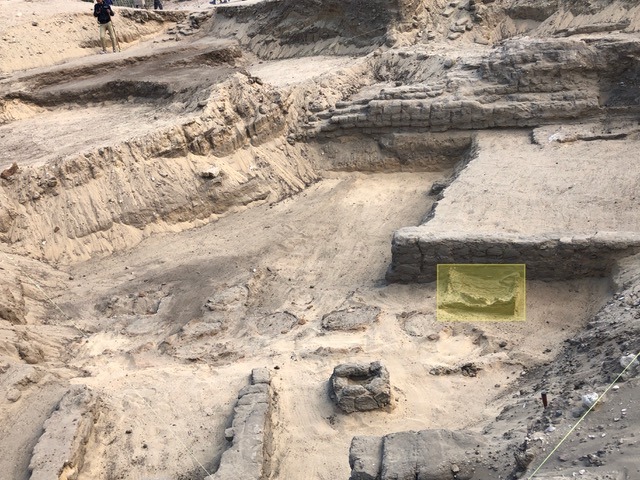Your browser is out-of-date!
Update your browser to view this website correctly. Update my browser now
Tear Mending Ha Chong-Hyun’s “Work 73-13”
by Laura Richter Le, with contributions by Diana Hartman Drumm
Laura Richter Le is the 2022-2023 Dedalus Fellow in Conservation, Conservation Center of the Institute of Fine Arts, NYU. Diana Hartman Drumm is Assistant Conservator, Paintings, Solomon R. Guggenheim Museum.
Modern artists have challenged tradition in a variety of ways, with innovative materials and experimental studio practices often playing a pivotal role. Recognizing the significance of this, Robert Motherwell believed each artist possesses “an extraordinary sensitivity to his medium,” adding, “I think the deepest discoveries in art have to do with the artist’s materials.” [1] Motherwell particularly believed in the power of abstracted forms in modern art to draw upon emotions and associations, and passionately fostered an appreciation for Modernism, which led him to write extensively on the subject and to create the Dedalus Foundation to that end [2].
Conservators have the privilege of seeing artists’ materials up close and exploring details of their practice. When we work on modern and contemporary art, unorthodox artistic materials and techniques can push us to look beyond traditional materials and practices. I have continually found that the challenges posed by uncommonly used artist materials encourage problem solving, research, and creativity in approaching treatments.
Over this past year, as the Dedalus Foundation Fellow in Conservation at the Institute of Fine Arts, NYU, I gained experience in the conservation of modern art through a variety of projects. I interned at Art Conservation Solutions and took a conservation class at Modern Art Conservation (both private practices specializing in modern and contemporary works), and also participated in conservation projects at the Solomon R. Guggenheim Museum. In this text, I have chosen to discuss an abstract artwork in the Guggenheim’s collection that prioritizes its materials as a source of meaning, and specifically to highlight the research tests that I carried out in support of the conservation treatment.

Image 1: Ha Chong-Hyun, Work 73-13, 1973. Barbed wire on jute, 120 × 240 cm. Solomon R. Guggenheim Museum, New York, Gift, the Samsung Foundation of Culture 2015.51
This spring, I worked with Diana Hartman Drumm, Assistant Paintings Conservator at the Guggenheim Museum, as she treated Work 73-13 (1973) by Ha Chong-Hyun (image 1). One of the most prominent artists of postwar and contemporary South Korea, Ha Chong-Hyun (하종현), was a leading member of Dansaekhwa, or the Korean Monochrome school, which emerged in the early 1970s. He is known for creating abstract works out of physically demanding studio processes, juxtaposing materials (including industrial and organic ones) and exploring the boundary between object and painting [3]. This work was produced during his time with the group Korean Avant-Garde Association (AG), which was known for its highly experimental approach to materials. During this period, Ha produced works that incorporated nails, metal springs, and barbed wire.
Work 73-13 is composed of a wood board support, with foam and jute canvas laid over it. The canvas stretches over the edges and is stapled to the back. A grid of barbed wire was placed on the surface and fastened with screws, pressing into the jute and foam and creating a quilted effect (see image 2). Ha created Work 73-13 in 1973, at a time when Park Chung Hee ruled as a military dictator and South Korea functioned as a military station for the United States. The barbed wire and jute are meant to refer to U.S. military bases, which were surrounded by barbed wire fences and had supplies shipped in jute sacks. These would have been familiar sights to those living in Seoul at the time, but even on their own, these materials are combined to evoke feelings of confinement and physical discomfort. The sharp barbed wire presses into the flesh-like surface of jute, which remains resilient and tough on the outside while compressing the soft, spongy layer below.

Image 2: Diagram of the layers in Work 73-13.
Various sources have identified the canvas material of this work (as well as others by Ha) as either jute or hemp. We knew that Ha used burlap sacks that were used to ship rice for the U.S. military, which he purchased at the Namdaemun Market in central Seoul [4]. Burlap, however, can be made from either jute or hemp. At my request, Denyse Montegut, a textile conservator who is an expert on fiber identification and was the Praska Distinguished Visiting Professor at the Institute of Fine Arts in Spring 2022, carried out a detailed analysis of the fibers from Ha’s Work 73-13, which I will briefly summarize here. First, Montegut examined the twist direction of internal fibrils within the larger cell walls. One twist direction indicates flax, ramie, or nettle, and the other indicates jute or hemp. In this case, the test confirmed that the fiber was either hemp or jute (image 3). Next, Montegut looked at cross sections of the fibers under high magnification, comparing a sample from Ha’s work with jute and hemp samples. This revealed wide and flat bundles of fibers, each of which had a noticeably polygonal shape, thick wall, and circular center (lumen). This was convincingly similar to the jute sample, whereas the hemp sample did not reveal a comparable structure (image 4). Since Montegut’s thorough analysis strongly supported a jute fiber identification, we decided to proceed with using jute for the testing and repair [5].
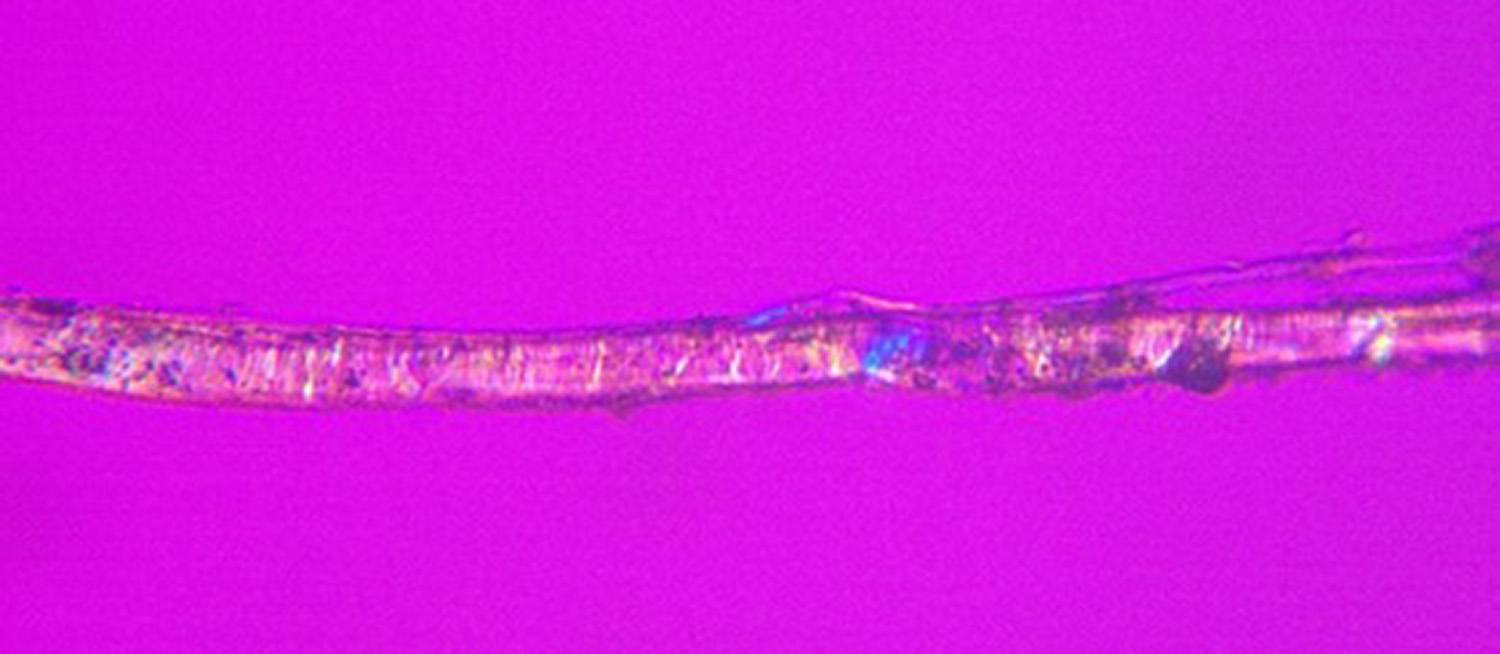
Image 3: A modified Herzog test [6] used to identify the internal twist of each fiber and confirming that the fabric was either hemp or jute. Image and interpretation by Denyse Montegut.
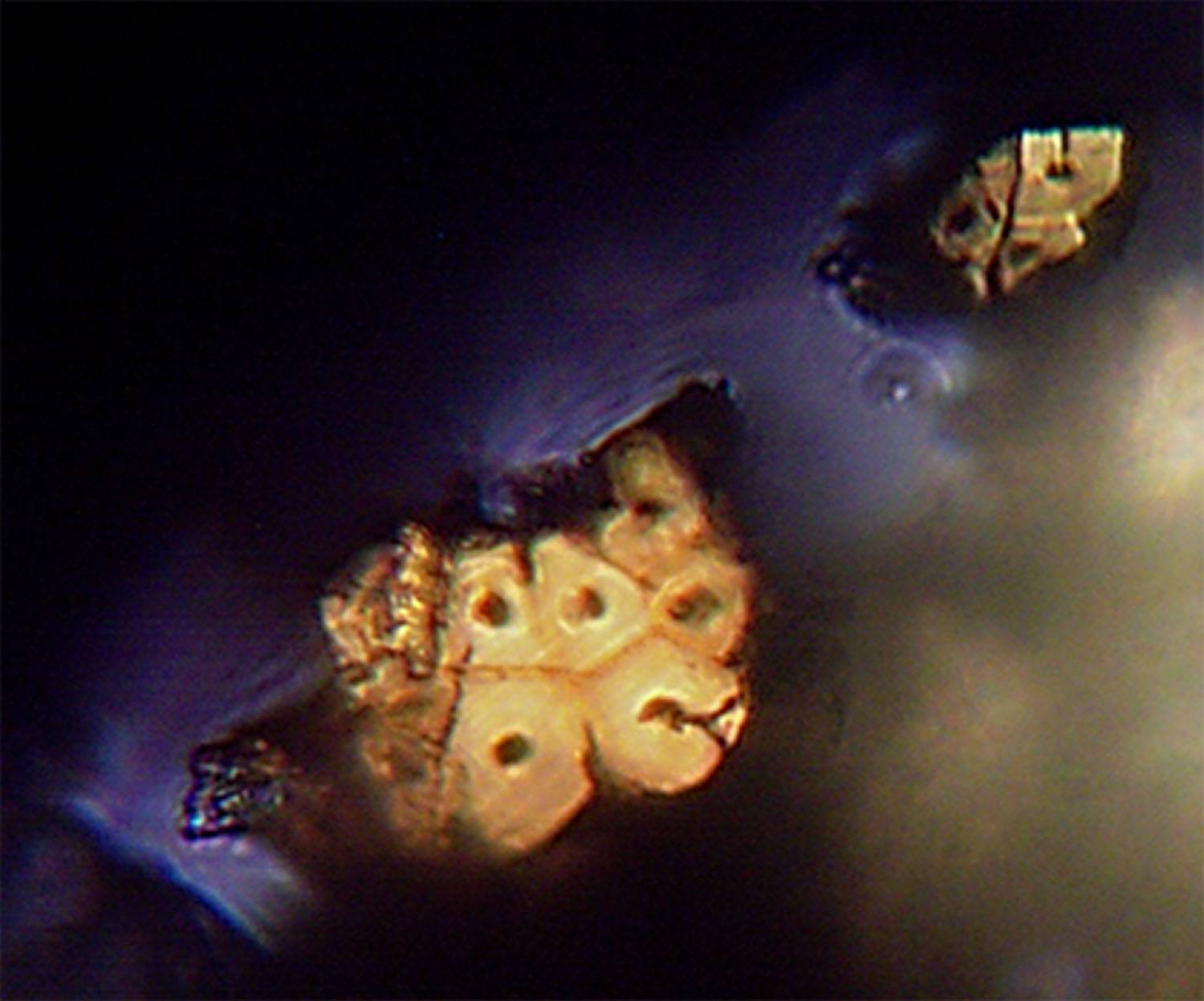

The work had five tears in the jute textile along the edges, ranging in length from half an inch to an inch and a half. Several of these tears left gaps in the canvas where the yellow foam below was exposed, interrupting the continuity of the piece (image 5). Unlike traditional paintings, where the canvas is covered in paint, every detail of a repair to the jute would be visible from the surface. As a result, it was especially important for the mend to blend seamlessly into the original. The best way of achieving this was the so-called thread-by-thread method of tear repair. This method involves reweaving and re-adhering each individual broken thread, adding material where the fibers have been lost. Although time-consuming, this restores the original system of tension within the painting, adds minimal materials, and visually blends with the surrounding canvas structure. Most tear repairs are fundamentally aimed at restoring the structural stability of the painting. In this repair, recreating the visual appearance of the textile surface was also critical to presenting an intact object.
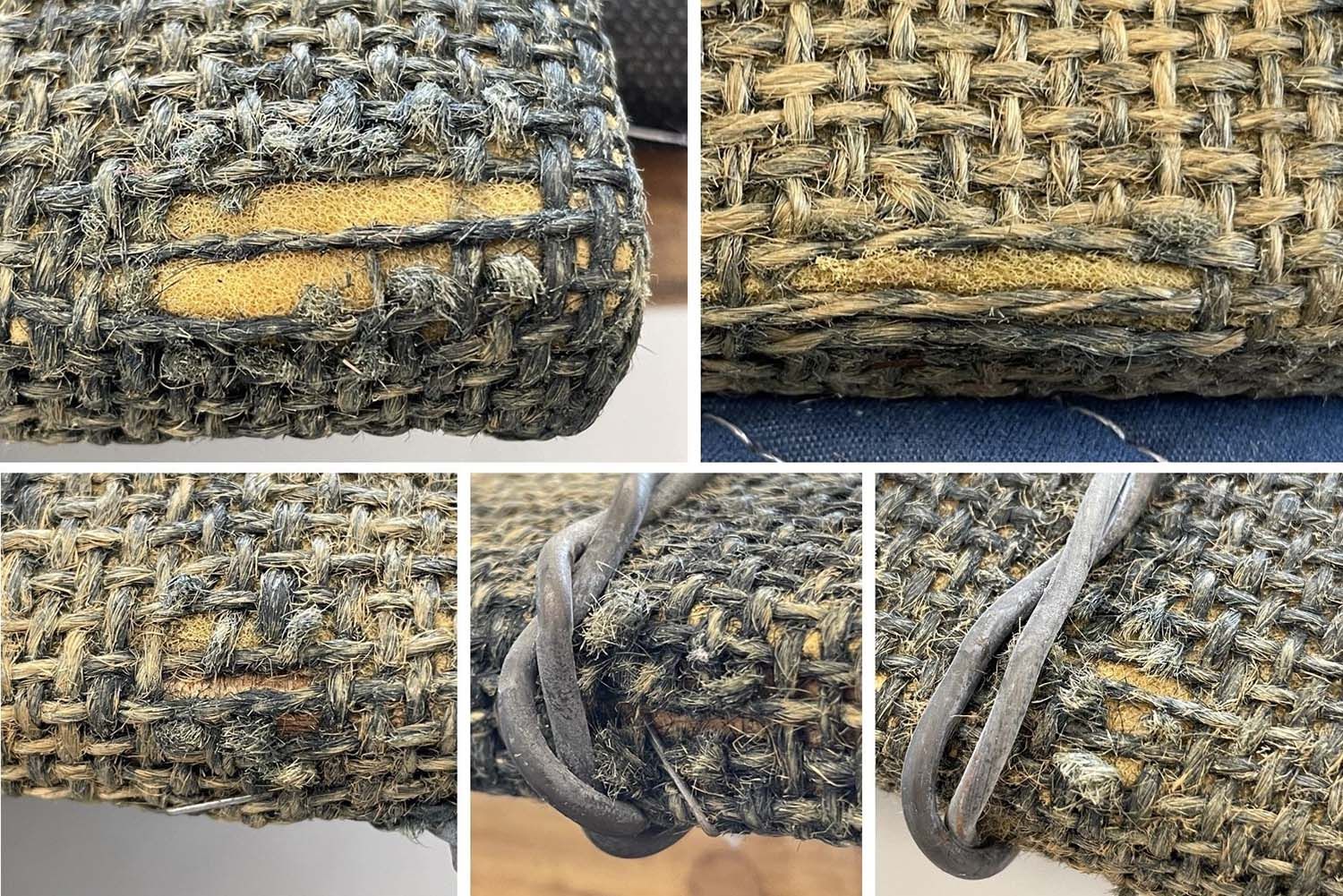
Image 5: The five tears along the edge of Work 73-13.
When repairing a tear in a painting, two of the most challenging aspects are often: (1) forming a bond between the old and new fibers that is strong enough to recreate the tension of the stretched canvas; and (2) working under a microscope with small threads that can be fragile or tangled in order to recreate the weave structure. This work, however, presented a slightly different set of challenges. The fabric is very thick and has an open weave, making it easy to see each fiber, and the foam and wood board below made it more challenging to manipulate the threads, especially when trying to weave new threads into already frayed jute fibers. Additionally, the fabric compressed the underlying layer of foam. As a result, the torn areas had begun to noticeably bulge outwards, and the repairs would need to be strong enough to withstand pressure from the foam below.
One of the main questions we had entering this project was how easily the jute threads would join back together to restore the visual continuity of the surface. Most methods for tear repair have been designed around linen (or sometimes cotton) canvas structures. Compared to linen, jute is rougher in appearance, usually with shorter fibers that can more easily fray. To better understand how jute would respond to treatment, and specifically what adhesive would yield the best results, I carried out tests on jute threads of a similar thickness to that of Ha’s Work 73-13.
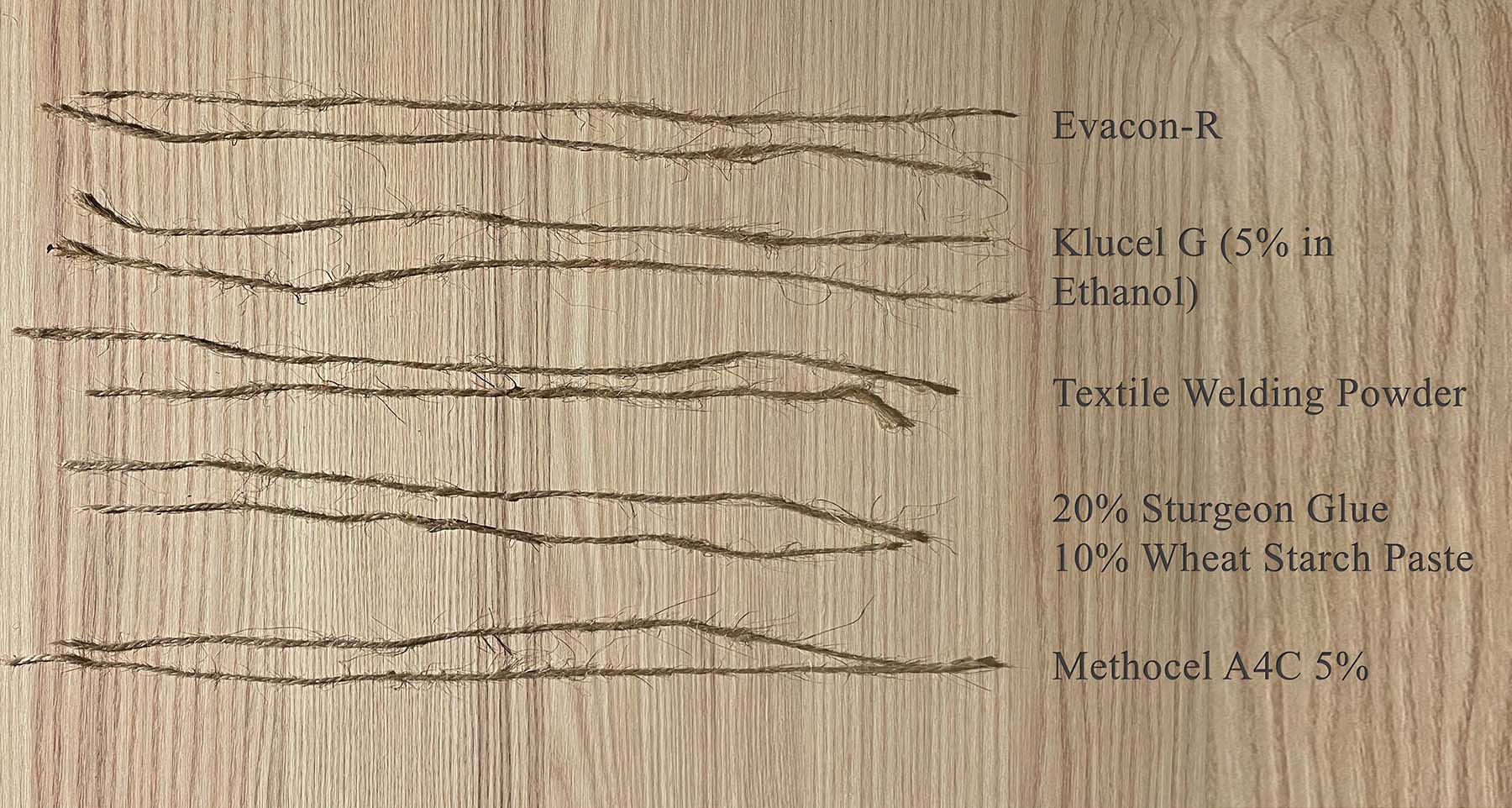
Image 6: Jute thread, each with a mend in the center. To account for variation, I did four tests for each adhesive, and two of each are shown above.
Sturgeon glue (a high-quality adhesive made from dried sturgeon bladders) remains one of the most widely used adhesives for thread-by-thread repair. When working on linen canvas, past studies have confirmed that a mixture of sturgeon glue and wheat starch paste has the highest success rate [7]. However, we suspected that jute thread would respond quite differently, so I tested a variety of adhesives that we were considering because they had been recommended in past tear repair studies. I broke and rejoined several threads with each adhesive, solidifying the bond by applying heat (image 6). To compare the strength of each mend, I tied metal weights to the ends of each thread, adding weights one by one until the join in the thread failed, and recorded the result (image 7).
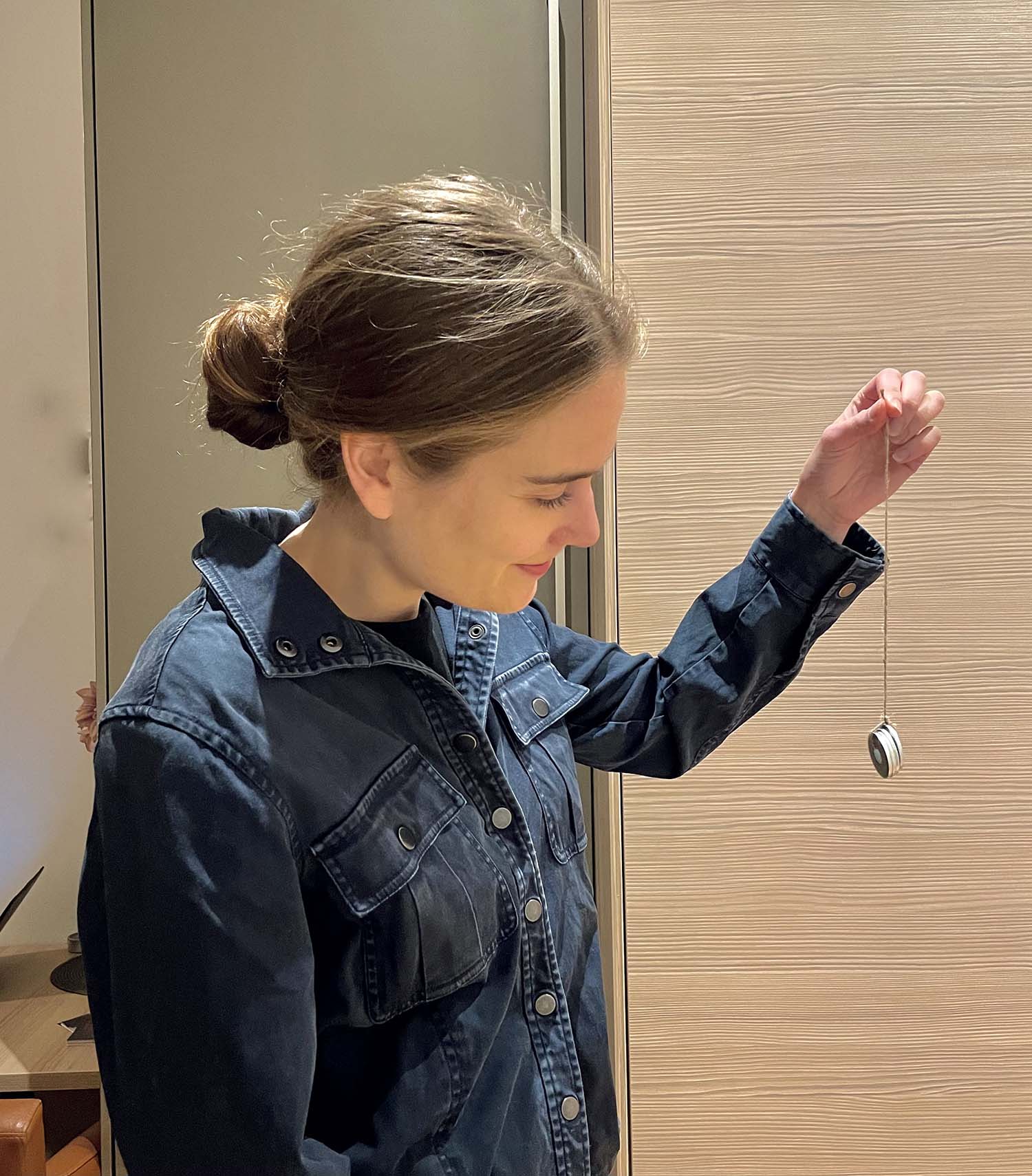
Image 7: Testing the strength of each thread, joined in the center with adhesive.
As suspected, jute responded differently than linen to the adhesives tested. For example, the sturgeon glue mixture did not solidify quickly enough to easily hold the heavy threads in place while wrapping them around one another. Additionally, when wetted with sturgeon glue, the jute thread frayed more easily while being manipulated. At the other end of the spectrum, textile welding powder, a thermoplastic powdered adhesive that is often used to repair textiles and leather, hardened the fastest but did not create as strong a bond as other adhesives. Even more problematic for this repair, the thermoplastic adhesive had a visual effect on the threads, darkening them and making them appear glossy. In the end, Evacon-R (an ethylene vinyl acetate dispersion), a relatively new adhesive in conservation, proved the easiest to work with and created the strongest and most flexible join between the threads [8].
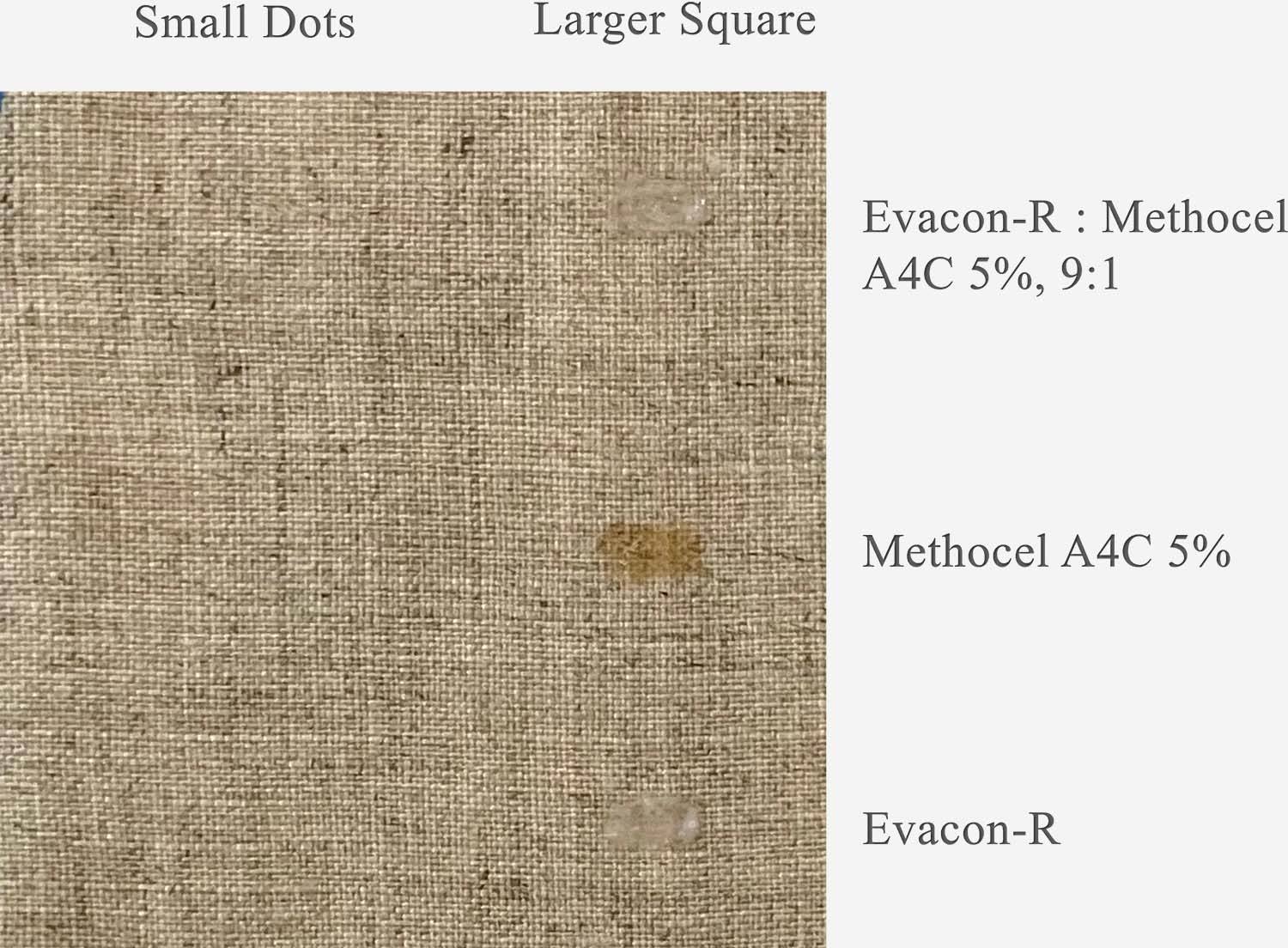
Image 8: Testing for discoloration.
Before we moved forward with using Evacon-R for the repair, I tested whether it would discolor the fabric. This was especially important, since the adhesive would be applied directly to the face of the work. Although I had not noted any visual changes to the material during strength testing, I proceeded to test the adhesive more extensively and on a larger scale, applying it both in small dots and in larger swatches in order to view any effects on a larger scale (image 8). Thankfully, Evacon-R had no effect on the color of the canvas.
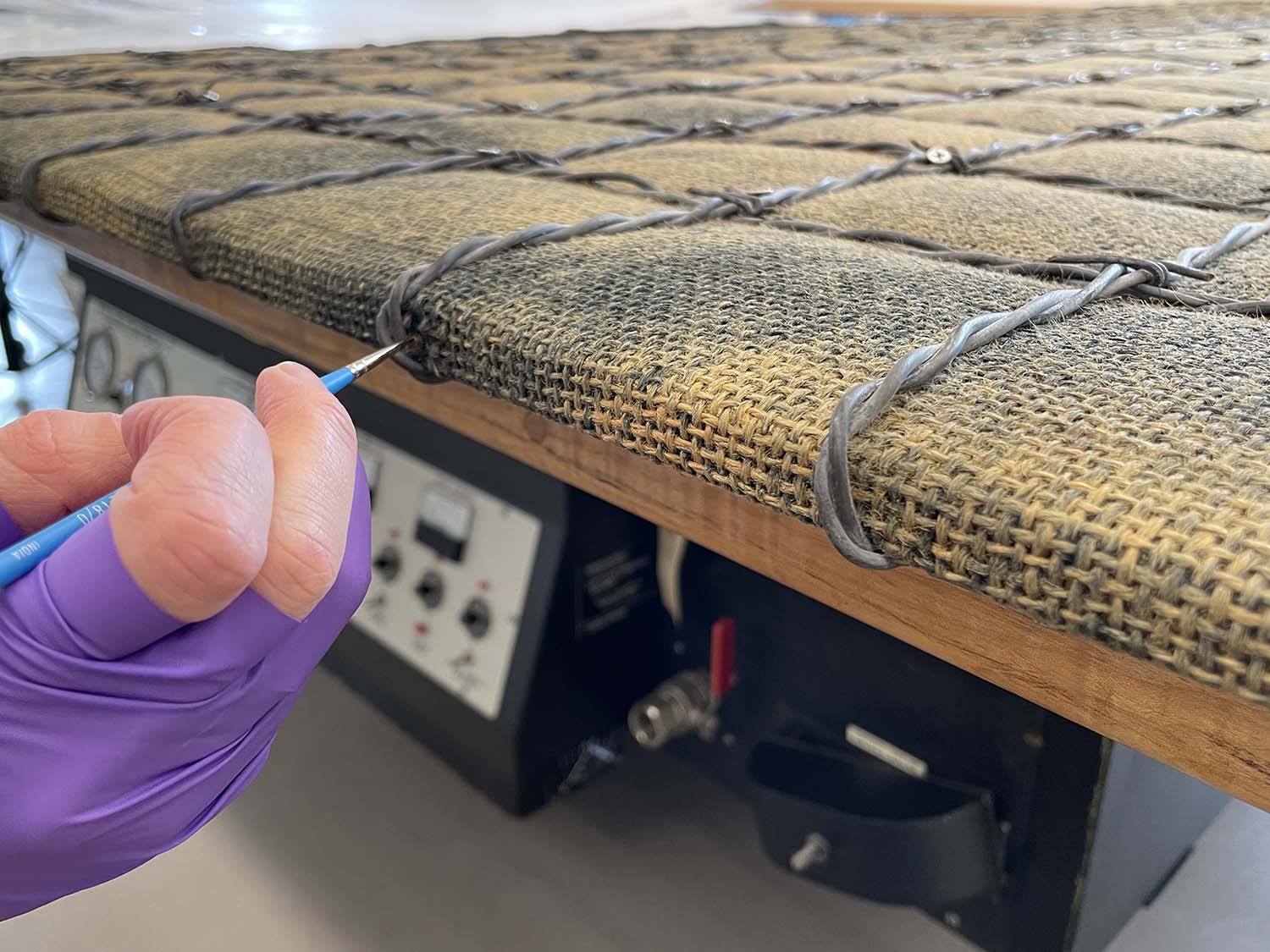
Image 9: Diana Hartman Drumm applying the adhesive to a tear on the edge.
Diana Hartman Drumm repaired the five tears seamlessly, starting with the smaller tears on the tacking edge (image 9) and proceeding to the largest on the surface (images 10 and 11). While tests like those I completed are helpful and important when making a successful treatment plan, one inevitably learns more about the specific material of the artwork during treatment. In this case, the aged threads on the work were more fragile than the new jute threads used for testing.
One advantage to conserving works by contemporary artists is the ability to consult the artist, and when appropriate, receive permission to proceed with certain aspects of the treatment. In this case, Ha agreed that threads from the back side of the work could be used to fill the gaps in the tears (see image 10). These would naturally blend into the design in a perfect way and would mean that original materials would serve as the primary material for repair. However, reweaving these rough and frayed threads and creating strong bonds with the original proved challenging. For the largest tear (image 11), Hartman Drumm used new jute thread as the repair material, coloring it with watercolors afterwards to blend with the original.

Image 10: Tear on the lower left edge repaired with original jute thread. Left: tear with a thread from the back placed on top, demonstrating how it visually integrates with the original; right: after treatment photograph.

Image 11: Tear on the lower right edge repaired with new jute thread. 1) Before treatment, 2) adding in new jute threads, 3) after the new threads have been adhered and trimmed, 4) after treatment, with the new threads.
Working on this project as the Dedalus Fellow reminded me that Robert Motherwell believed in interacting with art cross-culturally, fostering transnational discussions and understanding. He said of modern art: “it was essentially international in character…that it would blossom in its own way here as it had elsewhere, because beyond national differences there are human similarities that are more consequential.” [9] This universal, material language is a powerful tool for fostering empathy across our world. And on that note, learning more about Ha Chong-Hyun’s work, along with many other modern artists this year as a Dedalus Fellow, has been both meaningful and a pleasure.
Ha Chong-Hyun’s Work 73-13 is part of the exhibition, Only the Young: Experimental Art in Korea, 1960s–1970s, currently in Seoul, South Korea, and will be on view at the Guggenheim through January 7, 2024. [10] I hope you will consider seeing it displayed alongside many other works of Korean Experimental art (silheom misul) later this year.
. . . .
ENDNOTES
[1] As quoted in The Writings of Robert Motherwell (University of California Press, 2007), p. 196; 8.
[2] To read more about Motherwell and the Dedalus Foundation’s mission, see: https://dedalusfoundation.org/foundation/mission-ethos/.
[3] More can be found on the artist and this work on the Guggenheim’s website: https://www.guggenheim.org/teaching-materials/teaching-modern-and-contemporary-asian-art/ha-chong-hyun-하종현.
[4] For more information, see interview from the Korea Herald: http://www.koreaherald.com/view.php?ud=20201126000670&np=1&mp=1.
[5] Denyse Montegut’s full fiber ID report is on file at the Solomon R. Guggenheim Museum Conservation Lab.
[6] To read more about this process, see Christian Bergfjord and Bodil Holst, “A Procedure for Identifying Textile Bast Fibres Using Microscopy: Flax, Nettle/ramie, Hemp and Jute,” (Ultramicroscopy 110 [9], Elsevier: 1192–97, 2010).
[7] For more information, see Petra Demuth, Hanna Vogel, Christina Nägler, and Lena Reuber, “Review: Adhesives for Thread-by- Thread Tear Mending in Torn Fabric- Supported Paintings,” (CCI Symposium 2011).
[8] For more information on the result of the study, please contact the author at www.laurale.org.
[9] As quoted in Frank O’Hara, Robert Motherwell, with selections from the artist’s writings, (The Museum of Modern Art, New York, Doubleday and Co., 1965), p. 18.
[10] https://www.guggenheim.org/exhibition/experimental-art-in-korea-1960s-70s.

